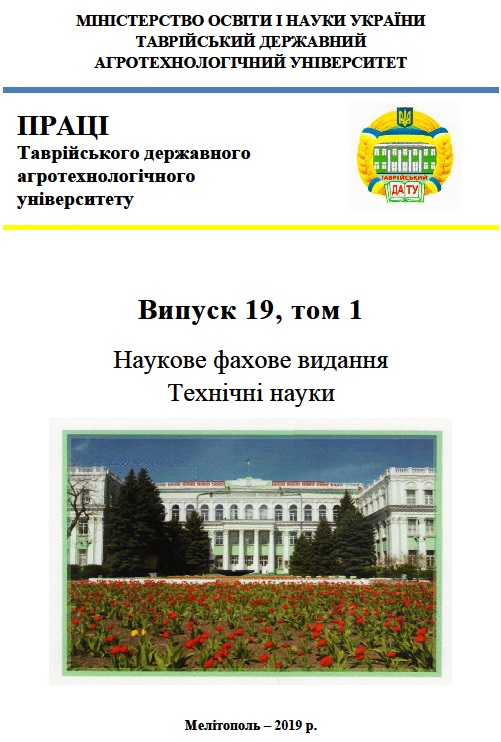ФІТОНУТРІЄНТИ БАЗИЛІКУ ВИРОЩЕНОГО В УМОВАХ ЗАХИЩЕНОГО ҐРУНТУ
Ключові слова:
базилік, фітонутрієнти, ефірні олії, поліфенольні речовини, пігменти
Анотація
Анотація – у роботі наведено результати досліджень біохімічного складу сортів зелені базиліку з різним забарвленням, вирощеного в умовах захищеного ґрунту. Встановлено, що сорти зі зеленим та змішаним забарвленням містили достовірно більшу кількість сухих розчинних речовин та вищу кількість ефірних олій. Фіолетові сорти базиліку характеризуються вищою кількістю поліфенольних речовин, але поступаються зеленим за вмістом аскорбінової кислоти.
Посилання
1. Weber C. F. Broccoli microgreens: a mineral-rich crop that can diversify food systems // Frontiers in nutrition. 2017. Vol. 4. Art. 7. DOI: 10.3389/fnut.2017.00007.
2. Рекомендації щодо здорового харчування дорослих. Затверджено МОЗ України від 08.12.2017 р. URL: http://moz.gov.ua/uploads/ckeditor/документи/01122017_Basic_Recommendations-1.pdf (дата звернення: 1.10.2018).
3. McDermott J.H. Antioxidant nutrients: current dietary recommendations and research update // Journal of the American Pharmaceutical Association. 2000. Vol. 40(6). Р. 785-799.
4. Garcıa-Closas R., Berenguer A., Tormo M. J. [et al.] Dietary sources of vitamin C, vitamin E and specific carotenoids in Spain // British Journal of Nutrition. 2004. Vol. 91. Р. 1005–1011.
5. La Vecchia C. Association between Mediterranean dietary patterns and cancer risk // Nutrition reviews. 2009. Vol. 67. P. 126-129.
6. Light quality affected growth and contents of essential oil components of japanese mint plants / N. Nishioka, Т. Nishimura, К. Ohyama, М. Sumino, S. Malayeri, Е. Goto, N. Inagaki, Т. Morota // International workshop on greenhouse environmental control and crop production in semi-arid regions: Tucson, AZ, USA, 2008. Р. 431–436.
7. Asami D. K., Hong Y.-J., Barrett D. M., Mitchell A. E. Comparison of the total phenolic and ascorbic acid content of freeze-dried and air-dried marionberry, strawberry, and corn grown using conventional, organic, and sustainable agricultural practices // J. Agric. Food Chem. 2003. Vol. 51. Р. 1237–1241.
8. Nutritional composition and flavonoid content of edible wild greens and green pies: a potential rich source of antioxidant nutrients in the Mediterranean diet / А. Trichopoulou, Е. Vasilopoulou, Р. Hollman, С. Chamalides, Е. Foufa, Т. Kaloudis, D. Kromhout, Ph. Miskaki, I. Petrochilou, Е. Poulima, К. Stafilakis // Food Chemistry. 2000. Vol. 70 (3). Р. 319-323.
9. Bower A., Marquez S., de Mejia E. G. The health benefits of selected culinary herbs and spices found in the traditional Mediterranean diet // Critical reviews in food science and nutrition. 2016. Vol. 56 (16). Р. 2728-2746.
10. Головко Т. К. Табаленкова Г. Н., Буткин А. В., Григорай Е. Е. Антиоксидантная активность и витаминная ценность зеленных культур защищенного грунта // Аграрный вестник Урала. 2010. № 9. С. 60-63.
11. Jayasinghe C., Gotoh N., Aoki T., Wada S. Phenolics composition and antioxidant activity of sweet basil (Ocimum basilicum L.) // Journal of Agricultural and Food Chemistry. 2003. Vol. 51(15). P. 4442-4449.
12. Juliani H. R., Simon J. E. Antioxidant activity of basil // Trends in new crops and new uses: ASHS Press, Alexandria, 2002. Р. 575-579.
13. Kwee E. M. Variations in phenolic composition and antioxidant properties among fifteen basil (Ocimum basilicum L.) cultivars // Food Chemistry. 2011. Vol.128. P. 1044-1050.
14. Effect of light quality on rosmarinic acid content and antioxidant activity of sweet basil, Ocimum basilicum L. / Т. Shiga, К. Shoji, Н. Shimada, S. N. Hashida, F. Goto, Т. Yoshihara // Plant biotechnology. 2009. Vol. 26(2). P. 255-259.
15. Hammock H. A. The Impact of Blue and Red LED Lighting on Biomass Accumulation, Flavor Volatile Production, and Nutrient Uptake in Hydroponically Grown Genovese Basil: Master's Thesis, University of Tennessee, 2018. URL: https://trace.tennessee.edu/utk_gradthes/5083 (дата звернення: 1.10.2018).
16. Heidari M. Effects of water stress and inoculation with plant growth promoting rhizobacteria (PGPR) on antioxidant status and photosynthetic pigments in basil (Ocimum basilicum L.) // Journal of the Saudi Society of Agricultural Sciences. 2012. Vol. 11(1). P. 57-61.
17. Effects of nitrogen fertilization on the phenolic composition and antioxidant properties of basil (Ocimum basilicum L.) // Agric. Food Chem. 2008. Vol. 56 (18). P. 8685-8869.
18. Burdina I., Priss O. Effect of the substrate composition on yield and quality of basil (Ocimum basilicum L.) // Journal of Horticultural Research. 2016. Vol. 24(2). P.109-118.
19. Методика дослідної справи в овочівництві і баштанництві / за ред. Г. Л. Бондаренко, К. І. Яковенко. Харків: Основа, 2001. 369 с.
20. Мусієнко М. М., Паршикова Т. В., Славний П. С. Спектрофотометричні методи в практиці фізіології, біохімії та екології рослин. Київ: Фітосоціоцентр, 2001. 200 с.
21. Найченко В. М. Практикум з технології зберігання і переробки плодів та овочів з основами товарознавства. Київ: ФАДА ЛТД, 2001. 211 с.
22. Методы биохимического исследования растений / под ред. А. И. Ермакова. Ленинград: Колос, 1972. С. 382-383.
23. Ma L., Dolphin D. The metabolites of dietary chlorophylls // Phytochemistry. 1999. № 50. Р. 195-202.
2. Рекомендації щодо здорового харчування дорослих. Затверджено МОЗ України від 08.12.2017 р. URL: http://moz.gov.ua/uploads/ckeditor/документи/01122017_Basic_Recommendations-1.pdf (дата звернення: 1.10.2018).
3. McDermott J.H. Antioxidant nutrients: current dietary recommendations and research update // Journal of the American Pharmaceutical Association. 2000. Vol. 40(6). Р. 785-799.
4. Garcıa-Closas R., Berenguer A., Tormo M. J. [et al.] Dietary sources of vitamin C, vitamin E and specific carotenoids in Spain // British Journal of Nutrition. 2004. Vol. 91. Р. 1005–1011.
5. La Vecchia C. Association between Mediterranean dietary patterns and cancer risk // Nutrition reviews. 2009. Vol. 67. P. 126-129.
6. Light quality affected growth and contents of essential oil components of japanese mint plants / N. Nishioka, Т. Nishimura, К. Ohyama, М. Sumino, S. Malayeri, Е. Goto, N. Inagaki, Т. Morota // International workshop on greenhouse environmental control and crop production in semi-arid regions: Tucson, AZ, USA, 2008. Р. 431–436.
7. Asami D. K., Hong Y.-J., Barrett D. M., Mitchell A. E. Comparison of the total phenolic and ascorbic acid content of freeze-dried and air-dried marionberry, strawberry, and corn grown using conventional, organic, and sustainable agricultural practices // J. Agric. Food Chem. 2003. Vol. 51. Р. 1237–1241.
8. Nutritional composition and flavonoid content of edible wild greens and green pies: a potential rich source of antioxidant nutrients in the Mediterranean diet / А. Trichopoulou, Е. Vasilopoulou, Р. Hollman, С. Chamalides, Е. Foufa, Т. Kaloudis, D. Kromhout, Ph. Miskaki, I. Petrochilou, Е. Poulima, К. Stafilakis // Food Chemistry. 2000. Vol. 70 (3). Р. 319-323.
9. Bower A., Marquez S., de Mejia E. G. The health benefits of selected culinary herbs and spices found in the traditional Mediterranean diet // Critical reviews in food science and nutrition. 2016. Vol. 56 (16). Р. 2728-2746.
10. Головко Т. К. Табаленкова Г. Н., Буткин А. В., Григорай Е. Е. Антиоксидантная активность и витаминная ценность зеленных культур защищенного грунта // Аграрный вестник Урала. 2010. № 9. С. 60-63.
11. Jayasinghe C., Gotoh N., Aoki T., Wada S. Phenolics composition and antioxidant activity of sweet basil (Ocimum basilicum L.) // Journal of Agricultural and Food Chemistry. 2003. Vol. 51(15). P. 4442-4449.
12. Juliani H. R., Simon J. E. Antioxidant activity of basil // Trends in new crops and new uses: ASHS Press, Alexandria, 2002. Р. 575-579.
13. Kwee E. M. Variations in phenolic composition and antioxidant properties among fifteen basil (Ocimum basilicum L.) cultivars // Food Chemistry. 2011. Vol.128. P. 1044-1050.
14. Effect of light quality on rosmarinic acid content and antioxidant activity of sweet basil, Ocimum basilicum L. / Т. Shiga, К. Shoji, Н. Shimada, S. N. Hashida, F. Goto, Т. Yoshihara // Plant biotechnology. 2009. Vol. 26(2). P. 255-259.
15. Hammock H. A. The Impact of Blue and Red LED Lighting on Biomass Accumulation, Flavor Volatile Production, and Nutrient Uptake in Hydroponically Grown Genovese Basil: Master's Thesis, University of Tennessee, 2018. URL: https://trace.tennessee.edu/utk_gradthes/5083 (дата звернення: 1.10.2018).
16. Heidari M. Effects of water stress and inoculation with plant growth promoting rhizobacteria (PGPR) on antioxidant status and photosynthetic pigments in basil (Ocimum basilicum L.) // Journal of the Saudi Society of Agricultural Sciences. 2012. Vol. 11(1). P. 57-61.
17. Effects of nitrogen fertilization on the phenolic composition and antioxidant properties of basil (Ocimum basilicum L.) // Agric. Food Chem. 2008. Vol. 56 (18). P. 8685-8869.
18. Burdina I., Priss O. Effect of the substrate composition on yield and quality of basil (Ocimum basilicum L.) // Journal of Horticultural Research. 2016. Vol. 24(2). P.109-118.
19. Методика дослідної справи в овочівництві і баштанництві / за ред. Г. Л. Бондаренко, К. І. Яковенко. Харків: Основа, 2001. 369 с.
20. Мусієнко М. М., Паршикова Т. В., Славний П. С. Спектрофотометричні методи в практиці фізіології, біохімії та екології рослин. Київ: Фітосоціоцентр, 2001. 200 с.
21. Найченко В. М. Практикум з технології зберігання і переробки плодів та овочів з основами товарознавства. Київ: ФАДА ЛТД, 2001. 211 с.
22. Методы биохимического исследования растений / под ред. А. И. Ермакова. Ленинград: Колос, 1972. С. 382-383.
23. Ma L., Dolphin D. The metabolites of dietary chlorophylls // Phytochemistry. 1999. № 50. Р. 195-202.
Опубліковано
2019-04-15
Як цитувати
Прісс, О., Коротка, І., Сердюк, М., & Сухаренко, О. (2019). ФІТОНУТРІЄНТИ БАЗИЛІКУ ВИРОЩЕНОГО В УМОВАХ ЗАХИЩЕНОГО ҐРУНТУ. Праці Таврійського державного агротехнологічного університету, 19(1). https://doi.org/10.31388/10.31388/2078-0877
Розділ
Харчові технології



